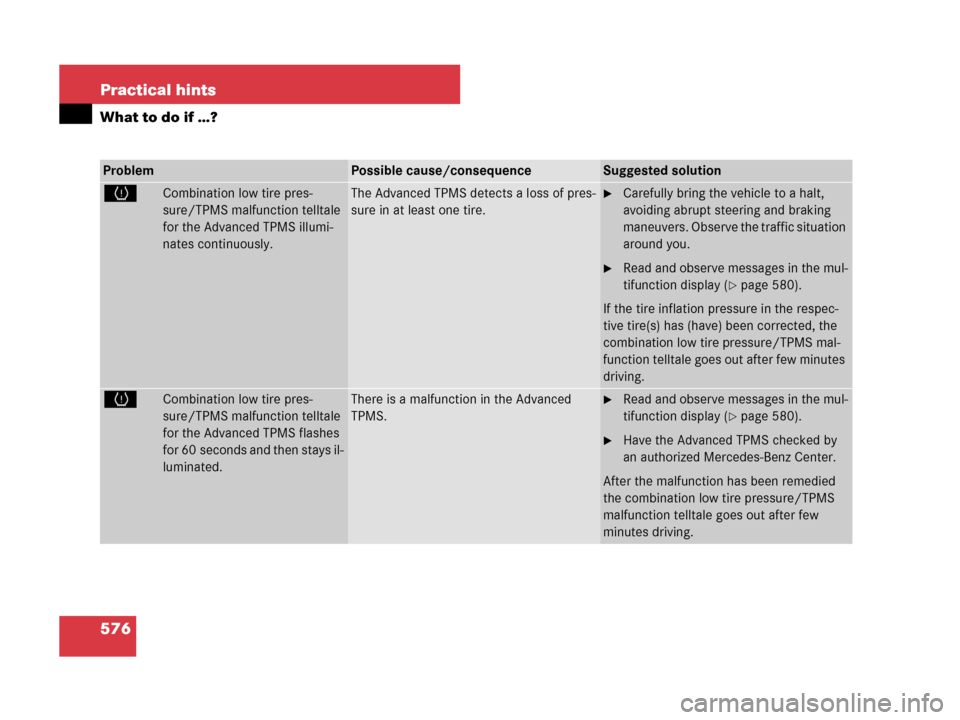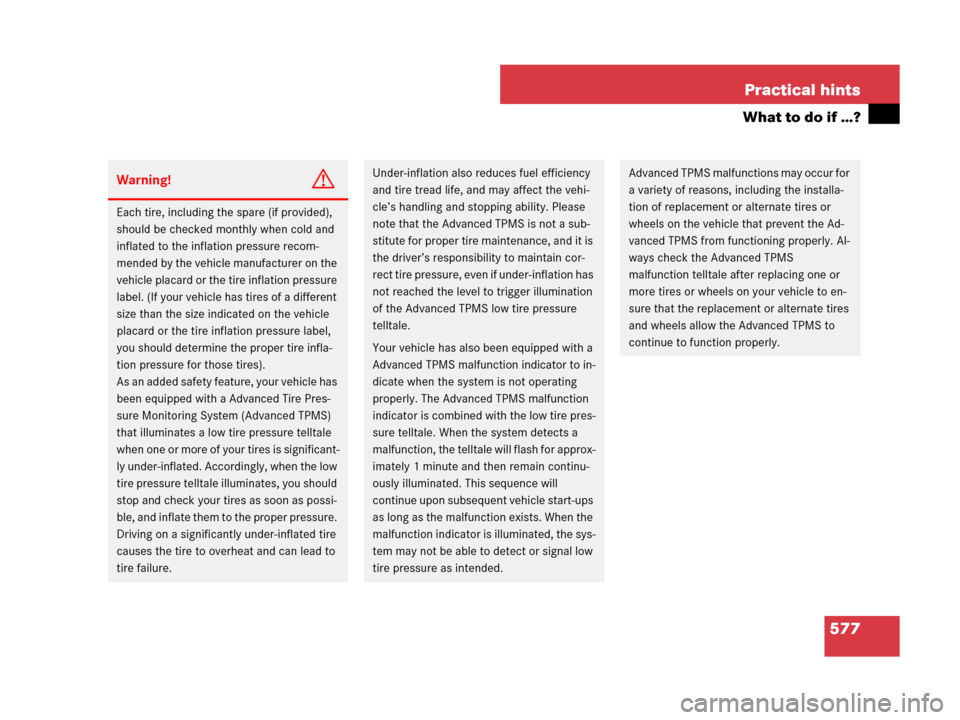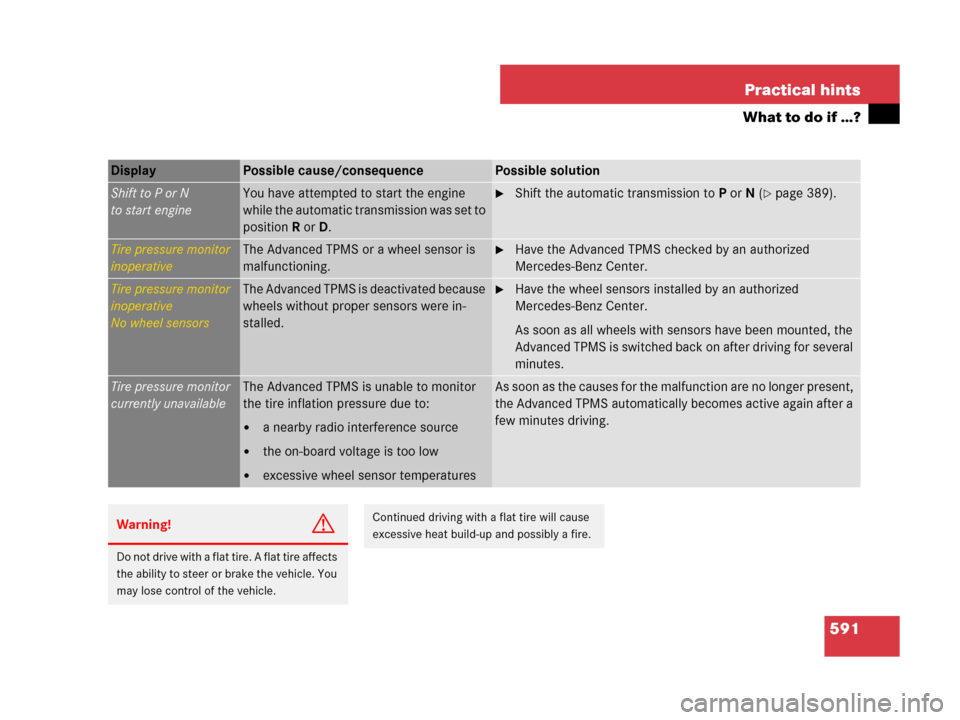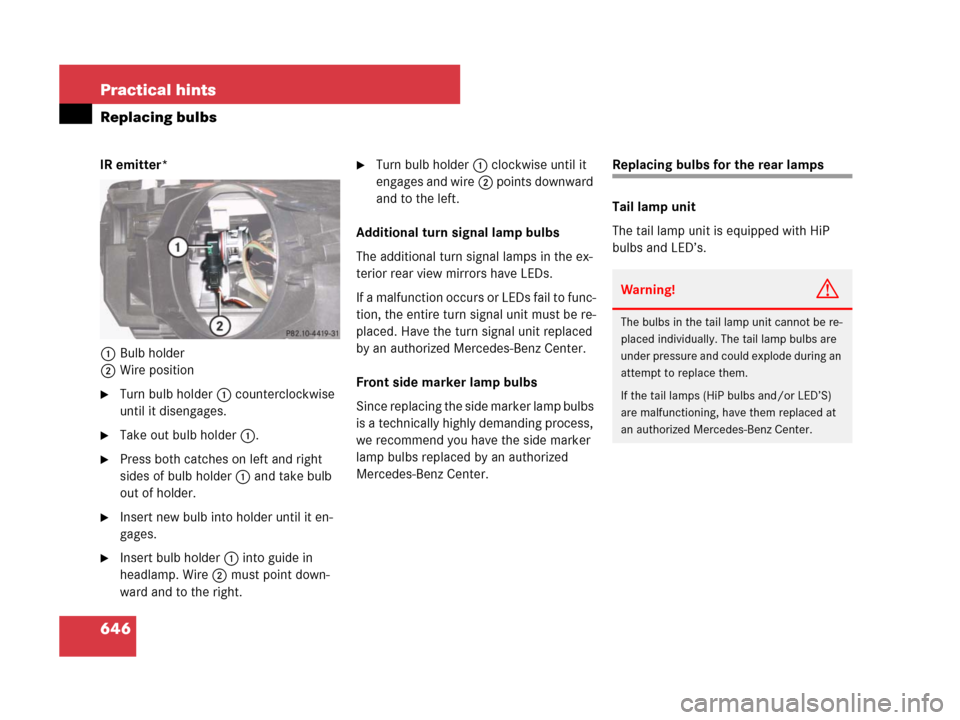Page 579 of 723

576 Practical hints
What to do if …?
ProblemPossible cause/consequenceSuggested solution
HCombination low tire pres-
sure/TPMS malfunction telltale
for the Advanced TPMS illumi-
nates continuously.The Advanced TPMS detects a loss of pres-
sure in at least one tire.�Carefully bring the vehicle to a halt,
avoiding abrupt steering and braking
maneuvers. Observe the traffic situation
around you.
�Read and observe messages in the mul-
tifunction display (
�page 580).
If the tire inflation pressure in the respec-
tive tire(s) has (have) been corrected, the
combination low tire pressure/TPMS mal-
function telltale goes out after few minutes
driving.
HCombination low tire pres-
sure/TPMS malfunction telltale
for the Advanced TPMS flashes
for 60 seconds and then stays il-
luminated.There is a malfunction in the Advanced
TPMS.�Read and observe messages in the mul-
tifunction display (
�page 580).
�Have the Advanced TPMS checked by
an authorized Mercedes-Benz Center.
After the malfunction has been remedied
the combination low tire pressure/TPMS
malfunction telltale goes out after few
minutes driving.
Page 580 of 723

577 Practical hints
What to do if …?
Warning!G
Each tire, including the spare (if provided),
should be checked monthly when cold and
inflated to the inflation pressure recom-
mended by the vehicle manufacturer on the
vehicle placard or the tire inflation pressure
label. (If your vehicle has tires of a different
size than the size indicated on the vehicle
placard or the tire inflation pressure label,
you should determine the proper tire infla-
tion pressure for those tires).
As an added safety feature, your vehicle has
been equipped with a Advanced Tire Pres-
sure Monitoring System (Advanced TPMS)
that illuminates a low tire pressure telltale
when one or more of your tires is significant-
ly under-inflated. Accordingly, when the low
tire pressure telltale illuminates, you should
stop and check your tires as soon as possi-
ble, and inflate them to the proper pressure.
Driving on a significantly under-inflated tire
causes the tire to overheat and can lead to
tire failure.
Under-inflation also reduces fuel efficiency
and tire tread life, and may affect the vehi-
cle’s handling and stopping ability. Please
note that the Advanced TPMS is not a sub-
stitute for proper tire maintenance, and it is
the driver’s responsibility to maintain cor-
rect tire pressure, even if under-inflation has
not reached the level to trigger illumination
of the Advanced TPMS low tire pressure
telltale.
Your vehicle has also been equipped with a
Advanced TPMS malfunction indicator to in-
dicate when the system is not operating
properly. The Advanced TPMS malfunction
indicator is combined with the low tire pres-
sure telltale. When the system detects a
malfunction, the telltale will flash for approx-
imately 1 minute and then remain continu-
ously illuminated. This sequence will
continue upon subsequent vehicle start-ups
as long as the malfunction exists. When the
malfunction indicator is illuminated, the sys-
tem may not be able to detect or signal low
tire pressure as intended.Advanced TPMS malfunctions may occur for
a variety of reasons, including the installa-
tion of replacement or alternate tires or
wheels on the vehicle that prevent the Ad-
vanced TPMS from functioning properly. Al-
ways check the Advanced TPMS
malfunction telltale after replacing one or
more tires or wheels on your vehicle to en-
sure that the replacement or alternate tires
and wheels allow the Advanced TPMS to
continue to function properly.
Page 594 of 723

591 Practical hints
What to do if …?
Display Possible cause/consequencePossible solution
Shift to P or N
to start engineYou have attempted to start the engine
while the automatic transmission was set to
position R or D.�Shift the automatic transmission to P or N (�page 389).
Tire pressure monitor
inoperativeThe Advanced TPMS or a wheel sensor is
malfunctioning.�Have the Advanced TPMS checked by an authorized
Mercedes-Benz Center.
Tire pressure monitor
inoperative
No wheel sensorsThe Advanced TPMS is deactivated because
wheels without proper sensors were in-
stalled.�Have the wheel sensors installed by an authorized
Mercedes-Benz Center.
As soon as all wheels with sensors have been mounted, the
Advanced TPMS is switched back on after driving for several
minutes.
Tire pressure monitor
currently unavailableThe Advanced TPMS is unable to monitor
the tire inflation pressure due to:
�a nearby radio interference source
�the on-board voltage is too low
�excessive wheel sensor temperatures
As soon as the causes for the malfunction are no longer present,
the Advanced TPMS automatically becomes active again after a
few minutes driving.
Warning!G
Do not drive with a flat tire. A flat tire affects
the ability to steer or brake the vehicle. You
may lose control of the vehicle.
Continued driving with a flat tire will cause
excessive heat build-up and possibly a fire.
Page 595 of 723
592 Practical hints
What to do if …?
Display Possible cause/consequencePossible solution
Tire pressures
displayed after driving
a few minutesThe tire inflation pressure is being checked.�Drive the vehicle for a few minutes.
Visit workshop
without shifting gearsThe automatic transmission cannot be shift-
ed out of the set position because of a
malfunction.If the automatic transmission is shift to positionD (�page 389):
�Without changing the automatic transmission from
positionD, drive to an authorized Mercedes-Benz Center.
If the automatic transmission is shift to positionN, R or P:
�Do not drive.
�Consult an authorized Mercedes-Benz Center.
Page 631 of 723
628 Practical hints
What to do if …?
Display Possible cause/consequencePossible solution
Tele Aid
inoperativeOne or more main functions of the Tele Aid
system are malfunctioning.�Have the Tele Aid system checked by an
authorized Mercedes-Benz Center.
Tire pressure
Caution, tire defectAdvanced TPMS:
One or more tires are deflating.�Carefully bring the vehicle to a halt, avoiding
abrupt steering and braking maneuvers.
�If necessary, change the wheel (�page 649).
Caution
Tire defectAdvanced TPMS:
One or more tires are deflating. The respec-
tive tire is shown in the multifunction
display.�Carefully bring the vehicle to a halt, avoiding
abrupt steering and braking maneuvers.
�If necessary, change the wheel (�page 649).
Warning!G
Do not drive with a flat tire. A flat tire affects
the ability to steer or brake the vehicle. You
may lose control of the vehicle. Continued
driving with a flat tire will cause excessive
heat build-up and possibly a fire.
Page 632 of 723
629 Practical hints
What to do if …?
Display Possible cause/consequencePossible solution
Tire pressure
Check tiresAdvanced TPMS:
The pressure is too low in one or more tires.�Carefully bring the vehicle to a halt, avoiding
abrupt steering and braking maneuvers.
�Check and adjust tire inflation pressure as
required (
�page 534).
�If necessary, change the wheel (�page 534).
Check tiresAdvanced TPMS:
The pressure is too low in one or more tires.
The respective tire is shown in the multi-
function display.�Carefully bring the vehicle to a halt, avoiding
abrupt steering and braking maneuvers.
�Check and adjust tire inflation pressure as
required (
�page 534).
�If necessary, change the wheel (�page 534).
Warning!G
Do not drive with a flat tire. A flat tire affects
the ability to steer or brake the vehicle. You
may lose control of the vehicle. Continued
driving with a flat tire will cause excessive
heat build-up and possibly a fire.
Page 633 of 723
630 Practical hints
What to do if …?
Display Possible cause/consequencePossible solution
Wheel sensor(s)
missingOne or more sensors malfunction (e.g. bat-
tery in one or more wheel sensor is empty).
One or more wheels without wheel sensors
mounted (e.g. spare tire).
No pressure value is shown on the multi-
function display for the tire in question.�Have the Advanced TPMS checked by an
authorized Mercedes-Benz Center.
�Have the wheel sensors installed by an
authorized Mercedes-Benz Center.
The tire pressure for the respective tire is
shown in the multifunction display after a few
minutes driving.
Tire pressure
Please rectifyAdvanced TPMS:
The pressure is too low in one or more tires.
Or the tire pressures of the individual
wheels differ too radically from one
another.�Check and adjust tire inflation pressure as
required (
�page 534).
Page 649 of 723

646 Practical hints
Replacing bulbs
IR emitter*
1Bulb holder
2Wire position
�Turn bulb holder1 counterclockwise
until it disengages.
�Take out bulb holder1.
�Press both catches on left and right
sides of bulb holder1 and take bulb
out of holder.
�Insert new bulb into holder until it en-
gages.
�Insert bulb holder1 into guide in
headlamp. Wire2 must point down-
ward and to the right.
�Turn bulb holder1 clockwise until it
engages and wire2 points downward
and to the left.
Additional turn signal lamp bulbs
The additional turn signal lamps in the ex-
terior rear view mirrors have LEDs.
If a malfunction occurs or LEDs fail to func-
tion, the entire turn signal unit must be re-
placed. Have the turn signal unit replaced
by an authorized Mercedes-Benz Center.
Front side marker lamp bulbs
Since replacing the side marker lamp bulbs
is a technically highly demanding process,
we recommend you have the side marker
lamp bulbs replaced by an authorized
Mercedes-Benz Center.Replacing bulbs for the rear lamps
Tail lamp unit
The tail lamp unit is equipped with HiP
bulbs and LED’s.
Warning!G
The bulbs in the tail lamp unit cannot be re-
placed individually. The tail lamp bulbs are
under pressure and could explode during an
attempt to replace them.
If the tail lamps (HiP bulbs and/or LED’S)
are malfunctioning, have them replaced at
an authorized Mercedes-Benz Center.